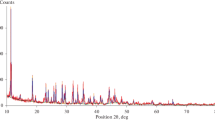Abstract
Generally, the rate of dehydroxylation of clay minerals may be controlled by reaction at the interface between the decomposed and undecomposed mineral, diffusion through the decomposed phase and/or nucleation of the decomposed phase. Only in rare instances are mineral decomposition reactions homogenous. Some examples are presented to illustrate these principles.
For macrocrystalline muscovite the initial sample weight rather than the external surface area was found to be a parameter of the rate of weight loss. Upon grinding the muscovite to particles smaller than — 65 mesh, an internal surface area factor strongly influenced the rate. This surface area was related to dislocations shown to be present in muscovite.
A rate equation is presented that explains the observed weight loss versus logarithm of time dependence based on a model involving a systematic relief of strain during dehydration.
The rate equation for pyrophyllite was exactly the same as that formulated for muscovite. As with muscovite there was a change in free energy of activation throughout the dehydration process. In contradiction to muscovite, the contribution to the free energy of activation was at least partly enthalpy while with muscovite it was an entropy of activation contribution.
The dehydration of kaolinite was carried out in vacuum. At pressures of one micron the reaction was found to be diffusion controlled with hydroxyl ions as the likely diffusing species.
Similar content being viewed by others
References
Amelinckx, S. and Delavignette, P. (1962) Dislocations in layer structure: in Direct Observations of Imperfections in Crystals, Interscience Publishers, New York London.
Billy, M. and Valensi, G. (1955) The kinetics of the formation of β silver sulphide and its relation to phenomena of electrochemical corrosion: in Proc. of the Sixth Meeting Inter. Com. Electrochem., Thermo., and Kinetics, 371, Butterworth Scientific Publ.
Brindley, G. W. and Nakahira, M. (1957) Kinetics of dehydroxylation of kaolinite and halloysite: in J. Am. Ceram. Soc., v.40, p.346.
Carter, R. E. (1961) Kinetic model for solid-state reactions: in J. Chem. Phys., v.34, p.2010.
Cook, M. A. and Oblad, A. G. (1953) Dynamic mechanism of heterogeneous catalysis: in Ind. Eng. Chem., v.45, p.1456.
Gandeeva, V. A., Zhabrova, G. M. and Kushnerev, M. Y. (1959) A kinetic, an adsorption, and an X-ray crystallographic study of the decomposition of magnesium carbonate: in Proc. Acad. of Sci., Phys. Chem. Soc, U.S.S.R.
Garner, W. E. (1955) Chemistry of the Solid State: Butterworth Scientific Publ.
Glasstone, S., Laidler, K. J. and Eyring, H. (1941) Theory of rate processes: in Kinetics of Chemical Reactions, Viscosity, Diffusion, and Electrochemical Phenomena, McGraw-Hill, New York, 611pp.
Holt, J. B., Cutler, I. B. and Wadsworth, M. E. (1958) Rate of thermal dehydration of muscovite: in J. Am. Ceram. Soc, v.41, p.7.
Holt, J. B., Cutler, I. B. and Wadsworth, M. E. (1962) Thermal dehydration of kaolinite in vacuum: in J. Am. Chem. Soc, v.45, p.133.
Hyatt, E. P., Cutler, I. B. and Wadsworth, M. E. (1956) An apparatus for thermogravimetric analyses: in Am. Ceram. Soc Bull., v.35.
Jander, W. (1937) Reactions in the solid state at high temperatures I. Rate of reaction for an endothermic change: in Z. Anorg. U. Allgen. Chem., v.163, p.1.
Johnson, W. A. and Mehl, R. F. (1939) Reaction kinetics in processes of nucleation and growth: in Trans. Am. Inst. Min. Met. Eng. v.135, p.416.
Mackenzie, R. C. and Milne, A. A. (1953) The effect of grinding on micas: in Mineral. Mag., v.30, p.178.
Milliken, T. H. Jr., Mills, G. A. and Oblad, A. G. (1950). Chemical characteristics and structure of cracking catalysts: in Disc Far. Soc., v.8-9, p.279.
Murray, P. and White, J. (1949) Kinetics of thermal dehydration of clays: in Trans. Brit. Ceram. Soc., v.48, p.187.
Murray, P. and White, J. (1955) Kinetics of thermal dehydration of clays: I. Dehydration characteristics of the clay minerals; II. Isothermal decomposition of the clay mineral; IV. Interpretation of differential thermal analysis of the clay mineral; in Trans. Brit. Cer. Soc., v.54, pp.137, 189, 204, respectively.
Taylor, H. A. and Thon, N. J. (1952) Kinetics of chemisorption: in J. Am. Chem. Soc., v.74, p.4169.
Toussaint, F., Firpiat, J. J. and Gostuche, M. C. (1963) Dehydroxylation of kaolinite. I. Kinetics: in J. Phys. Chem., v.67, p.26.
Author information
Authors and Affiliations
Rights and permissions
About this article
Cite this article
Holt, J.B., Cutler, I.B. & Wadsworth, M.E. Kinetics of the Thermal Dehydration of Hydrous Silicates. Clays Clay Miner. 12, 55–67 (1963). https://doi.org/10.1346/CCMN.1963.0120109
Published:
Issue Date:
DOI: https://doi.org/10.1346/CCMN.1963.0120109




